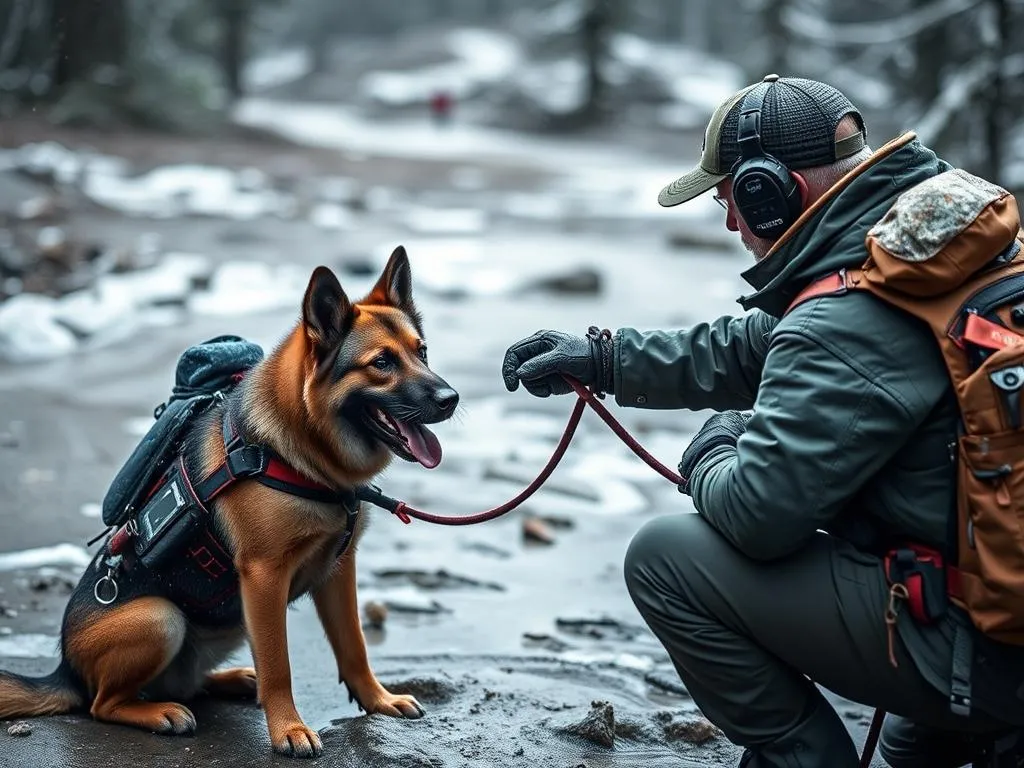
Introduction
Search and rescue (SAR) dogs play a critical role in emergency situations, providing invaluable assistance in locating missing persons and helping to save lives. Their unique skills and instincts make them indispensable in various scenarios, including natural disasters, wilderness searches, and urban environments. Training a SAR dog is a meticulous process that requires dedication, knowledge, and a deep understanding of canine behavior.
The journey to becoming an effective SAR team involves not only the dog but also the trainer. Both must possess specific skills and attributes to work in harmony. In this guide, we will explore how to train a search and rescue dog, covering everything from understanding the role of SAR dogs to advanced training techniques and certification processes.
Understanding Search and Rescue Dogs
Definition of Search and Rescue Dogs
Search and rescue dogs are specially trained canines that assist in locating missing persons or victims in disaster situations. Their keen sense of smell and ability to navigate diverse environments allow them to perform vital tasks in SAR operations. These dogs can be involved in various types of missions, including disaster response, where they search through rubble and debris, and missing person searches, where they track scents to find individuals.
Breeds Best Suited for Search and Rescue
Not all dog breeds are equally suited for search and rescue work. Some of the breeds commonly recognized for their excellent SAR capabilities include:
- Labrador Retriever: Known for their friendly nature and strong work ethic, Labradors are often employed in SAR operations due to their versatility.
- German Shepherd: Highly intelligent and trainable, German Shepherds excel in tracking and protection, making them ideal for SAR teams.
- Bloodhound: Renowned for their extraordinary sense of smell, Bloodhounds are unparalleled in tracking scents over long distances.
These breeds share specific characteristics that make them suitable for SAR work, including high energy levels, strong instincts, and a willingness to please their handlers.
Roles and Responsibilities of a SAR Dog
SAR dogs perform various tasks that are essential to successful rescue missions. These tasks include:
- Scent Detection: Using their acute sense of smell to locate individuals.
- Tracking: Following a scent trail to find the person.
- Area Search: Scanning large areas to identify a missing person.
Effective communication and teamwork between the handler and the dog are crucial for success. A well-trained SAR dog relies on its handler for guidance and support during missions.
Pre-Training Considerations
Assessing the Dog’s Suitability
Before embarking on training, it’s essential to assess whether your dog has the right traits for SAR work. Look for:
- Energy Level: High-energy dogs are typically more engaged and willing to participate in rigorous training.
- Temperament: A stable and friendly temperament is vital for ensuring the dog can handle the various stressors encountered in SAR work.
Additionally, health checks and vaccinations are crucial to ensure your dog is physically fit and ready for the demands of training.
Building a Bond with Your Dog
Establishing a strong bond with your dog is vital for effective training. Techniques to build trust include:
- Positive Reinforcement: Rewarding your dog with treats, praise, or playtime for desirable behaviors fosters a strong connection.
- Socialization: Exposing your dog to different environments, people, and sounds ensures they are well-adjusted and less likely to be distracted during SAR operations.
A solid relationship between you and your dog will enhance communication and cooperation during training and missions.
The Trainer’s Role
An effective SAR dog trainer must possess specific qualities, including:
- Patience: Training a SAR dog can be a lengthy and sometimes frustrating process, requiring a calm and patient approach.
- Consistency: Regular training routines and consistent commands help reinforce learning.
- Communication: Clear communication between the trainer and the dog is essential for success.
Understanding the dog’s body language and emotional state will also help you tailor your training approach.
Foundations of Training
Basic Obedience Training
Before delving into specialized SAR training, it’s crucial to establish a foundation of basic obedience. Key commands include:
- Sit
- Stay
- Come
- Heel
These commands are fundamental for ensuring your dog can respond appropriately in various situations, especially during SAR missions.
Socialization Skills
Socialization is a critical component of training a SAR dog. Expose your dog to various environments, including:
- Crowded places
- Different terrains (e.g., woods, urban settings)
- Various sounds (e.g., sirens, construction noise)
Positive experiences in these settings will help your dog remain focused and calm during real SAR operations.
Conditioning and Physical Fitness
Physical fitness is paramount for SAR dogs, as they often face demanding conditions. Suggested exercises to improve your dog’s stamina and strength include:
- Long walks or hikes: Encourages endurance and exposes the dog to different environments.
- Agility training: Enhances coordination and builds muscle strength.
- Fetch games: Promotes cardiovascular fitness while reinforcing the bond with your dog.
Ensure your dog is in peak physical condition to handle the rigors of SAR tasks.
Specialized Search and Rescue Training Techniques
Scent Detection Training
Scent work is a fundamental aspect of SAR training. To teach scent recognition, follow these steps:
- Select a Specific Scent: Begin with a distinct item, such as a piece of clothing or a scent pad.
- Introduce the Scent: Allow your dog to sniff the item and reward them for showing interest.
- Reinforce Recognition: Gradually increase the distance between the scent and your dog, encouraging them to locate it while rewarding successful finds.
This process helps the dog learn to associate specific scents with rewards, enhancing their ability to detect scents during SAR operations.
Tracking and Trailing Techniques
Understanding the difference between tracking and trailing is crucial:
- Tracking: Following the scent of a person’s footsteps.
- Trailing: Pursuing a scent left by a moving person.
To teach tracking skills, use items like scent trails or articles left by the missing person. Start with short tracks and gradually increase the distance and complexity as your dog becomes more proficient.
Area Search Training
To train your dog for area searches, utilize the following techniques:
- Divide the Search Area: Break down large areas into smaller sections.
- Use Rewards: Encourage your dog to search by rewarding them for indicating areas where scents may be present.
- Increase Complexity: Gradually increase the search area and introduce distractions to enhance their focus.
Reinforcement strategies, such as praise and treats, are essential for keeping your dog motivated throughout the training process.
Disaster Response Training
Preparing for disaster scenarios requires specialized training. Simulate environments such as rubble or debris fields to familiarize your dog with these conditions. Key components include:
- Environmental Familiarity: Allow your dog to explore various disaster environments to build confidence.
- Adaptive Skills: Teach your dog to navigate different terrains and obstacles, ensuring they can adapt during real-life missions.
This training prepares your dog for the unpredictable nature of disaster response situations.
Advanced Training and Certification
Continued Education for SAR Dogs
Ongoing training is vital for SAR dogs to refine their skills and stay sharp. Look for advanced training programs and workshops that focus on specialized techniques and scenarios.
Certification Process
Most SAR teams require certification to ensure operational standards. Certification requirements typically include:
- Proficiency in scent detection, tracking, and area searches
- Successful completion of a series of practical tests
Organizations such as the National Association for Search and Rescue (NASAR) provide certification and adhere to established standards.
Building a SAR Team
Teamwork and communication are essential in SAR operations. Integrating your dog into a larger SAR unit involves:
- Regular Team Drills: Practice coordinated searches with your dog and other team members.
- Communication Skills: Develop clear signals and commands that facilitate teamwork during missions.
A well-integrated SAR team enhances the overall effectiveness of search operations.
Challenges in Search and Rescue Dog Training
Common Training Challenges
Training a SAR dog can present various challenges, including:
- Behavioral Issues: Distractions or fear responses may hinder training progress.
- Addressing Anxiety: Techniques such as desensitization and gradual exposure can help manage fear or anxiety in dogs.
Identifying and addressing these challenges early on is crucial for successful training.
Maintaining Motivation
Keeping your dog engaged during training is essential. Techniques to maintain motivation include:
- Variety in Training: Incorporate different exercises and environments to keep training fresh.
- Rewards: Use a mix of treats, praise, and playtime to reinforce positive behaviors.
A motivated dog is more likely to excel in SAR training.
Handling Stressful Situations
Preparing dogs for high-stress environments is vital. Strategies for managing stress include:
- Gradual Exposure: Introduce your dog to stressful situations incrementally to build resilience.
- Calm Environment: Practice in controlled settings before moving to more chaotic environments.
Managing both the dog’s and handler’s stress levels is essential for effective SAR operations.
Conclusion
Training a search and rescue dog is a rewarding experience that requires time, patience, and dedication. The bond formed between the handler and the dog is crucial for success in SAR operations. By understanding the unique needs of SAR dogs and following a structured training plan, you can prepare your dog for the challenges they will face in the field.
As you embark on this journey, remember that the process can be demanding but immensely fulfilling. With perseverance and commitment, you and your dog can become a skilled and effective search and rescue team.









